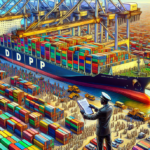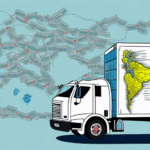Understanding International Shipping and DDP
Expanding your e-commerce business globally introduces a multitude of challenges, from navigating diverse customs regulations to managing complex logistics. International shipping requires compliance with the destination country's laws, coordination with multiple parties like freight forwarders and customs brokers, and meticulous documentation. One solution that can streamline this process is Delivered Duty Paid (DDP) shipping.
According to the 2023 E-commerce Report by Statista, global e-commerce sales are projected to reach $6.3 trillion by 2024, underscoring the growing importance of efficient international shipping solutions like DDP.
How DDP Shipping Works
Definition and Process
DDP, or Delivered Duty Paid, is an international shipping method where the seller assumes full responsibility for delivering goods to the buyer's location, including all import tariffs, taxes, and customs duties. This means the seller handles everything from freight forwarding and customs clearance to final delivery.
Key Steps in the DDP Shipping Process
- Freight Forwarding: Transportation of goods from the origin to the destination.
- Customs Clearance: Submission of necessary documentation and payment of duties.
- Compliance Checks: Ensuring all regulatory requirements are met.
- Final Delivery: Transporting goods to the buyer's doorstep.
Benefits of DDP Shipping for E-commerce Businesses
Enhanced Customer Experience
With all duties and fees paid upfront, customers enjoy a seamless purchasing experience without unexpected charges upon delivery. This can lead to higher customer satisfaction and increased repeat business.
Cost Savings and Efficiency
By consolidating shipments and optimizing routes, DDP shipping providers often offer competitive rates. This can be particularly advantageous for small businesses looking to scale without incurring prohibitively high shipping costs.
Compliance and Risk Management
DDP shipping ensures that all customs regulations are adhered to, reducing the risk of fines and shipment delays. According to U.S. Trade Administration, proper compliance can decrease the likelihood of shipment seizures and legal issues.
Comparing DDP with Other Shipping Methods
DDP vs. FOB (Free on Board)
While DDP places the responsibility for shipping, including duties and taxes, on the seller, FOB requires the buyer to handle these aspects once the goods are on board the transport vessel.
DDP vs. DDU (Delivered Duty Unpaid)
DDU allows the buyer to pay duties and taxes upon delivery, whereas DDP includes these costs in the shipping process, offering a more predictable cost structure for the buyer.
Control Over Shipment
DDP provides sellers with greater control over the shipping process, ensuring compliance and timely delivery. In contrast, methods like EXW (Ex Works) offer buyers more control but require them to manage logistics and compliance.
Key Considerations and Best Practices for DDP Shipping
Essential Documentation
Successful DDP shipping hinges on accurate and complete documentation. Key documents include:
- Commercial Invoice
- Bill of Lading
- Packing List
- Certificate of Origin
- Any required licenses or permits
Failure to provide these can result in delays, fines, or seizure of goods.
Choosing the Right Shipping Provider
Select a provider with a strong reputation, expertise in your target market, transparent pricing, and robust customer support. Reviews and case studies can offer insights into a provider's reliability and service quality.
Cost Management
Understand all cost factors, including transportation, customs clearance fees, duties, taxes, and insurance. Transparent pricing from your shipping provider can help in accurately forecasting and managing shipping expenses.
Challenges and Solutions in DDP Shipping
Common Challenges
- Unexpected customs fees and duties
- Delays in transit
- Compliance issues with varying international regulations
- Accurate classification of products
Overcoming Challenges
Maintain close communication with your shipping provider, conduct thorough research on destination regulations, and ensure all documentation is meticulously prepared. Partnering with experienced providers can mitigate many of these risks.
Future Trends and Case Studies in DDP Shipping
Growing Importance in Cross-Border E-commerce
The rise of global e-commerce is driving the adoption of DDP shipping. As businesses expand their international presence, the need for streamlined and compliant shipping solutions becomes increasingly critical.
Successful Implementations
Major e-commerce platforms like Amazon, Alibaba, and eBay have effectively utilized DDP shipping to enhance their global reach and customer satisfaction.
Expert Insights
Industry experts highlight the balance between cost and control as a pivotal factor in choosing DDP shipping. While it offers enhanced customer experience and compliance, businesses must weigh these benefits against the higher costs involved.
Conclusion
DDP shipping presents a robust solution for e-commerce businesses aiming to expand internationally. By handling all aspects of the shipping process, including duties and compliance, DDP offers a seamless experience for both sellers and buyers. As global e-commerce continues to grow, adopting DDP shipping can position businesses for sustained international success.






















